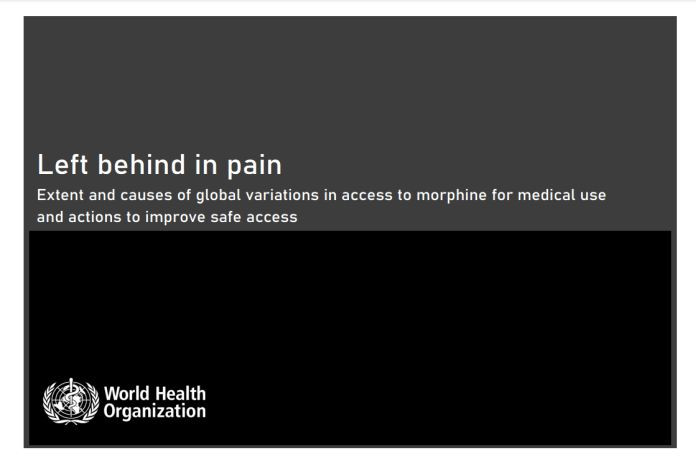GENEVA, Switzerland, (WHO) – The World Health Organization (WHO) has published a new report on access to morphine for medical use, which describes how the global distribution of morphine, as a vital pain medicine, is unequal and does not fulfil the medical need. The report, titled: “Left behind in pain”, highlights the problems in access to this essential medicine and offers actions to improve safe access through balanced policy.
Despite morphine being an effective and relatively low-cost medicine for relieving strong pain, listed since 1977 in the first edition of the WHO Model list of Essential Medicines, the disparity in access across countries is stark. There is a 5- to 63-fold difference in the estimated median consumption of morphine between high-income countries and lower income countries.
Consumption pattern varies significantly across countries of similar wealth; it does not correspond to medical need, as indicated by the estimated number of days people are in pain or suffer with severe shortness of breath for people with a terminal illness.
This data echoes that of the 2018 Lancet Commission which described the lack of access to pain relief medication as ‘one of the most heinous, hidden inequities in global health’ with the richest 10 percent of countries possessing 90 percent of distributed morphine-equivalent opioids.
“Leaving people in pain when effective medicines are available for pain management, especially in the context of end-of-life care, should be a cause of serious concern for policymakers,” says Dr Yukiko Nakatani, WHO assistant director-general for medicines and health products. “We must urgently advocate for safe and timely access to morphine for those in medical need through balanced policy, everywhere.”
Reasons for the disparity
Access to morphine for medical use is influenced by many interacting factors including enablers related to good governance, reliable/efficient procurement and supply processes, resource availability and capacity-building activities, along with barriers related to overly restrictive legislation and policies, inadequate service provision, and misinformed attitudes and perception.
Given different country contexts, enablers, barriers and priorities for action vary; a stakeholder survey presented in this report, with respondents from 105 WHO Member States, confirms this variation. For example, irregular supply of morphine and other strong opioids at health facilities due to limited financing were commonly noted as a barrier in low- and middle-income countries compared to high-income countries. More than a third of respondents across all regions also noted barriers arising from legislative and regulatory factors while recognizing the importance of a legislative and regulatory framework in achieving safe access. Unduly restrictive requirements could hamper patient access because they impede the flow of supply or make prescribing and dispensing difficult for healthcare professionals.
It is important to note that concerns about the potential harmful effects of opioids are valid, such as their potential to lead to opioid use disorder. For this reason, a certain amount of caution about the potential harms of opioid use (e.g. use in chronic non-cancer pain) is important for public health insofar as its use is well-informed and proportionate to risks. Such concerns should not undermine the benefits of opioid use when clinically indicated and when used safely by trained professionals.
Opportunities for action
The report presents a complementary set of areas for action that aim to improve safe access to morphine. These include implementing small-scale regional or state-wide programmes on improving access to morphine for medical use with a package of essential services and products for palliative care that is formulated according to the WHO Model List of Essential Medicines and the WHO Essential Package of Palliative Care.
They also include improving governance, streamlining procurement and supply processes to address any inefficiency, improving resourcing such as stable funding, enhancing competent skill sets of the health workforce, and raising awareness about both the benefits and potential harms of opioid use. The success of these actions will hinge on collaboration and cooperation among all stakeholders at national, regional, and global levels.





